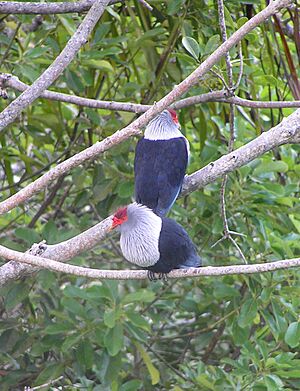Blue pigeon facts for kids
Quick facts for kids Blue pigeon |
|
|---|---|
 |
|
| Seychelles blue pigeon | |
| Scientific classification |
|
| Kingdom: | Animalia |
| Phylum: | Chordata |
| Class: | Aves |
| Order: | Columbiformes |
| Family: | Columbidae |
| Subfamily: | Treroninae |
| Genus: | Alectroenas G.R. Gray, 1840 |
| Species | |
|
see text |
|
The blue pigeons are a group of birds in the dove and pigeon family, called Columbidae. They belong to a special group, or genus, named Alectroenas. These colorful pigeons live on islands in the western Indian Ocean.
Contents
Meet the Blue Pigeons
Blue pigeons are medium to large birds. They are quite stocky and have long wings and tails. A cool feature is the special feathers on their head and neck. These feathers can move around! Their legs are also quite unique, with a long upper part and a shorter lower part.
Where Do Blue Pigeons Live?
These pigeons are found on islands across the western Indian Ocean. They are very closely related to each other. Because they live on different islands, they are considered a "superspecies." This means they are all part of one big family that spread out.
Today, there are three types of blue pigeons still alive:
- The Madagascar blue pigeon
- The Comoros blue pigeon
- The Seychelles blue pigeon
Sadly, three other types of blue pigeons used to live on the Mascarene islands. But these are now extinct, meaning they are gone forever:
- The Mauritius blue pigeon
- The Rodrigues blue pigeon
- The Réunion blue pigeon
How Did They Get Here?
Scientists think blue pigeons might have traveled from island to island. They "island hopped" across the ocean. This helped them become a unique group of birds. Their closest living relative is the cloven-feathered dove. This dove lives far away in New Caledonia. Blue pigeons and this dove separated about 8 to 9 million years ago. Their ancestors might have been the fruit doves from Southeast Asia and Oceania.
Naming the Blue Pigeons
The group Alectroenas was first named in 1840. An English zoologist named George Robert Gray gave them this name. The name Alectroenas comes from ancient Greek words. Alectruōn means "domestic cock," and oinas means "pigeon."
Extinct Blue Pigeons
Besides the three living species, there are also two species that became extinct a long time ago. These might have been part of the Alectroenas group:
- The Rodrigues blue pigeon
- The Réunion blue pigeon
The Réunion blue pigeon was described by a traveler named Sieur Dubois in 1674. He said they were "wild pigeons" with "slaty-coloured feathering." He also mentioned they were a bit bigger than European pigeons. They had red bills and eyes like pheasants. These pigeons were very tasty, according to Dubois.
It's believed the Réunion blue pigeon survived until the early 1700s. But by 1705, all native pigeons on Réunion were gone. It's possible that new animals brought to the island, like cats and rats, caused their extinction.

